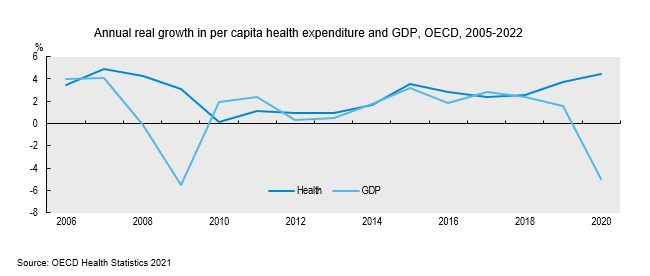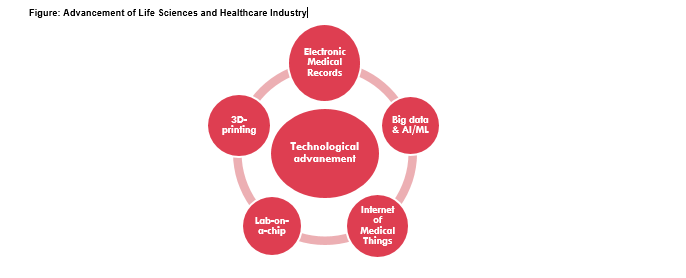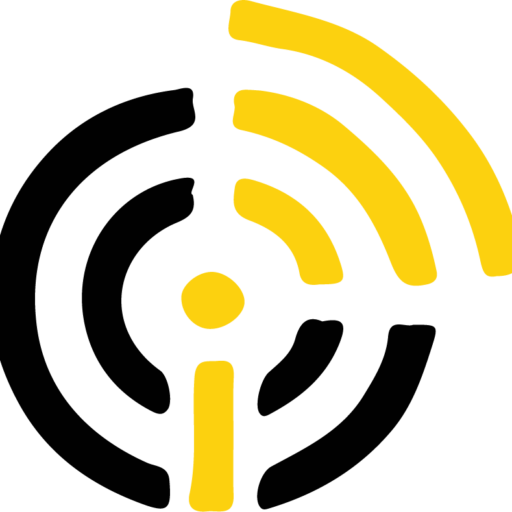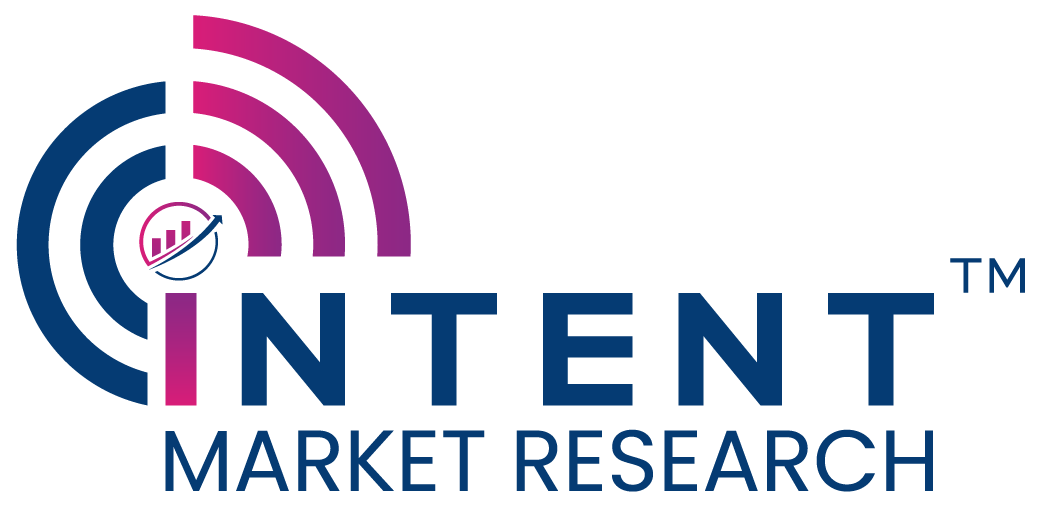LifeSciences and Healthcare
Innovations in the life sciences and healthcare sector are constantly revolutionizing this sector. Participant organizations involved in this sector are actively researching, developing, and launching new products and services. Emerging technologies are opening up new avenues in the fields of medical robotics, genomics, and AI, which are further expected to improve the quality of life. COVID-19 has accelerated numerous existing and emerging trends.
Developments in the field of lab-grown organs, 3D printing, remote patient monitoring, and wearable devices allow better opportunity and treatment options. There are tremendous developments in gene editing technologies, such as CRISPR-Cas9, base editing, and Transcription Activator-Like Effector Nucleases (TALENs) which has allowed scientists to make more precise and informed decisions.
Key benefits of these innovations in the healthcare industry such as improved diagnosis, reduced cost of care, better treatment opportunities and quality of life have a positive impact on the market growth.
Health expenditure in relation to gross domestic product
Healthcare spending patterns vary considerably across the globe, showcasing the distinct priorities, challenges, and other economic landscapes of individual nations and regions. In the MEA region, for instance, governments on average allocate a mere 8% of their budgets to healthcare, less than the 17% invested by Organization for Economic Cooperation and Development (OECD) nations. Within the Gulf Cooperation Council (GCC) countries, Kuwait emerges prominently, dedicating USD 8.9 billion to its 2021-2022 healthcare budget.
This considerable expenditure is a result of Kuwait’s growing population, rapid urbanization, and distinct health concerns. Meanwhile, Europe has its distinct dynamics. In 2020, 10.9% of the European Union’s GDP went towards healthcare. Countries such as Germany and France were leading, contributing over 12.0% of their GDP to healthcare expenditures. Between 2019 and 2020, health expenditure per capita in the EU rose by 5.5%.

Elsewhere, India’s Central and State Governments touched 2.1% of the GDP for healthcare in 2023, a gradual rise from 1.6% in 2021. As per the Centers for Medicare and Medicaid Services, the US in particular, had its immense healthcare expenditure, reaching USD 4.3 trillion in 2021, averaging USD 12,914 per person. Moreover, private health insurance spending grew 5.8% to USD 1,211.4 billion in 2021. Such figures emphasize the US’s health-centric spending, with the country dedicating 17.8% of its GDP to healthcare in 2021, almost double the average expenditure by OECD countries, highlighted by the Commonwealth Fund.
Pfizer, Merck, Sanofi, GSK, Torrent, are the major players in the pharmaceutical market
Collaboration across the industry players becomes crucial, allowing the integration of diverse expertise. The synergy between healthcare and life sciences businesses holds the promise of creating a brighter, healthier tomorrow for all. Pfizer, Merck, Sanofi, GSK, Torrent, are few of the giants in pharmaceuticals, leading in research and development.
Medtronic, Johnson & Johnson, GE Healthcare, and Siemens Healthineers are the giants in the medical device market
Abbott, Roche, GE Healthcare, Medtronic, Stryker, Thermo Fisher Scientific, Boston Scientific Corporation, BD, Philips and Zimmer Biotech specializes in medical imaging and diagnostics. These companies significantly contribute to fostering growth through innovation, maintaining high standards of quality, and providing value. Furthermore, they distribute reliable products on a global scale, earning trust and recognition worldwide. Johnson & Johnson covers everything from baby care to biopharmaceuticals. Hologic leads in women’s health technology. Integra LifeSciences, a medical device company manufactures products for skin regeneration, neurosurgery, reconstructive and general surgery. Organogenesis focuses on regenerative medicine. Sophia Genetics integrates AI in genetic diagnostics.
Pioneering tomorrow’s healthcare through technological advancement
Technology has advanced by leaps and bounds, bringing about changes in healthcare and life sciences industry. With an access to cutting edge technologies, remote consultations with experts and the availability of intuitive mobile applications have facilitated remote patient monitoring.

Big data and AI/Ml is reshaping the healthcare industry
Big Data and AI/ML stand out due to their positive impact across industries. AI applied to big data offers ground-breaking opportunities to transform the drug discovery process. Robotic systems are being developed using AI and machine learning to replace humans. For instance, in July 2021, Google DeepMind developed AlphaFold, an AI system that predicts protein structures with remarkable accuracy, potentially enhancing biochemistry.
Figure: Key Players – Life Sciences and Healthcare Industry

The transformative impact of internet of medical things
It comprises a network of devices and mobile phone applications to track and prevent serious events in the course of chronic illness, helping patients and doctors for better monitor and management of such conditions. This wearable can help monitor fever, blood sugar level, or pulse. For instance, Medtronic has developed advanced wearable devices that can relay data to physicians for better patient management. Additionally, Medtronic and DaVita have launched a new company to develop new tech for kidney health.
The power and potential of 3D printing
With the capability to construct body parts such as artificial veins, implants, bionic prostheses, and various customized surgical tools, the future of 3-D printing is vast. This will soon be a reality. For instance, Redington entered into an agreement with ETEC, Materialise, and Wipro encouraging 3D printing’s role in manufacturing. The partnership will be utilized for the distribution of their newly launched ‘polymer 3D printer’ across the country.
Electronic medical records (HER) is redefining the future of healthcare
EHR help save summaries of a patient’s medical records such as lab records, prescriptions, and details of hospital stays digitally. Such digital records facilitate the sharing of information between specialists and labs, thus improving coordination. For instance, in April 2023, Microsoft and Epic collaborated to utilize the power of generative artificial intelligence to improve the accuracy and efficiency of HER.
The game-changing impact of lab-on-a-chip (LOC) technology
A LOC is a compact device, executing a range of laboratory tasks like DNA sequencing, PCR, and biochemical detection. Leveraging microfluidic technologies, these devices can produce millions of microchannels. The benefits of using LOC devices include lowered diagnostic costs, high accuracy, and reduced human involvement. For instance, in December 2021, Bionano Genomics Inc. launched BioDiscovery’s NxClinical software for genome analysis, offering enhanced features for the visualization, interpretation, and reporting of next-generation sequencing data, specifically in the areas of genetic disorders and cancer.
The healthcare and life sciences domain is a dynamic and vital space, shaped by technological advancements, global health challenges, and shifting consumer expectations, among others. As we look to the future, this sector promises not only advancements in science but for the betterment of humanity as well.
At Intent Market Research, we provide detailed studies to assist healthcare organizations in understanding their customers’ needs and crafting successful growth plans.

